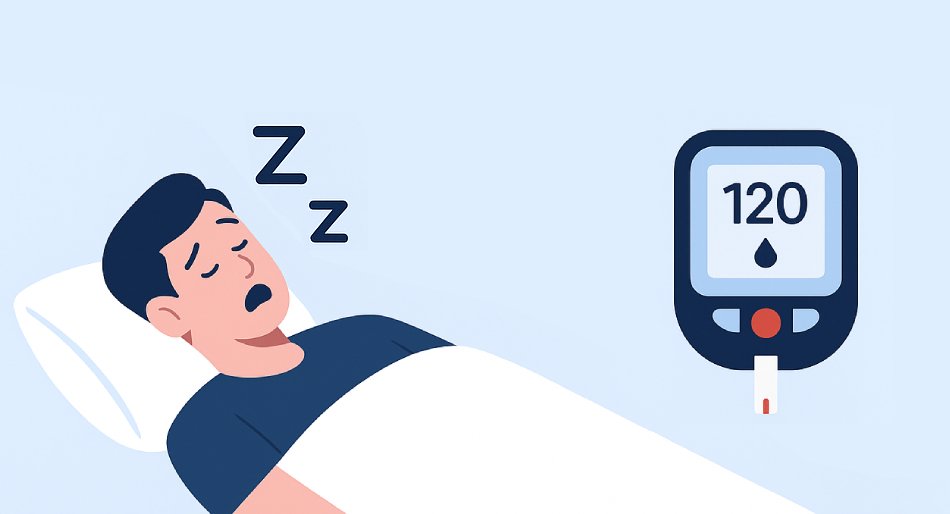We often joke about snoring, treating it as something “funny” or “annoying” for our partners. But in reality, snoring can be the tip of the iceberg for a serious sleep disorder—Obstructive Sleep Apnea (OSA).
Now, combine that with diabetes, one of the world’s fastest-growing health crises, and we have a dangerous partnership that silently destroys health. The most fascinating—and worrying—part? OSA and diabetes fuel each other in a vicious cycle.
In this blog, let’s unravel this connection, understand the warning signs, explore modern diagnostic tools (including AI-based technologies), and see how management and prevention can change lives.
The Bidirectional Link: Why OSA and Diabetes are Partners in Crime
Most people know obesity increases the risk for both OSA and diabetes, but the relationship goes much deeper:
- How OSA drives diabetes:
- Every time the airway collapses during sleep, oxygen levels drop (intermittent hypoxia).
- The brain releases stress hormones like cortisol and adrenaline.
- This leads to insulin resistance, poor glucose metabolism, and weight gain.
- Over years, it increases the risk of developing type 2 diabetes and heart disease.
- How diabetes worsens OSA:
- High sugar levels damage nerves and muscles (neuropathy), weakening airway tone.
- Fat deposits around the neck and tongue increase airway collapsibility.
- Poor glucose control worsens inflammation and fluid retention—further narrowing airways.
👉 This two-way street explains why many patients struggle with uncontrolled sugars despite medications, or why OSA patients often have difficulty losing weight and stabilizing diabetes.
🚨 Warning Signs You Should Never Ignore
Snoring may sound harmless, but when combined with other symptoms, it’s a red flag:
- Loud, habitual snoring—especially if it disturbs others
- Pauses in breathing or gasping during sleep
- Excessive daytime sleepiness (falling asleep at work, while driving, or watching TV)
- Morning headaches or dry mouth
- Poor concentration, memory issues, or irritability
- Weight gain and difficulty controlling diabetes despite diet and medication
If you have diabetes and these signs, OSA screening becomes non-negotiable.
🩺 How We Diagnose: From Sleep Labs to AI
Traditionally, OSA diagnosis relied on overnight sleep studies (polysomnography), where multiple sensors track brain activity, breathing, oxygen, and heart rhythm. While this remains the gold standard, it’s expensive, time-consuming, and not easily accessible to all.
Newer, practical approaches include:
- Screening Questionnaires – Tools like STOP-BANG or Berlin help identify risk in clinics.
- Home Sleep Tests (HSTs) – Portable devices that measure oxygen and airflow while you sleep at home.
- AI-based Photoplethysmography (PPG):
- A breakthrough in diagnosis!
- PPG uses light-based sensors (like those in smartwatches and pulse oximeters) to measure subtle changes in blood flow.
- With the help of AI algorithms, these signals can detect apnea events, oxygen drops, and even sleep patterns—without bulky equipment.
- This technology makes large-scale, low-cost, and early screening possible, especially in diabetic populations.
This shift toward AI-driven, contactless, and wearable-based tools means OSA can be detected much earlier, even before complications set in.
⚕️ Management: Breaking the Cycle for Better Health
Once diagnosed, OSA is very treatable—and treating it improves both sleep and diabetes control.
- Lifestyle Measures:
- Weight loss (even 5–10% can significantly reduce OSA severity).
- Regular exercise improves insulin sensitivity and airway tone.
- Avoid alcohol, sedatives, and smoking, which worsen airway collapse.
- Train yourself to sleep on your side, not your back.
- Medical Treatments:
- CPAP (Continuous Positive Airway Pressure): Gold standard therapy. Patients often notice dramatic improvements in energy, mood, blood sugar levels, and heart health.
- Oral Appliances: Custom dental devices move the jaw forward to keep the airway open—effective in mild to moderate cases.
- Surgery: For select patients, surgical options like uvulopalatopharyngoplasty (UPPP) or hypoglossal nerve stimulation can help.
- Managing Diabetes Hand-in-Hand:
- Treating OSA improves insulin sensitivity and helps stabilize sugars.
- Conversely, good glucose control reduces OSA severity.
- This synergistic approach is the key to better outcomes.
🛡️ Prevention: Don’t Wait for the Crisis
The good news? Both OSA and diabetes can often be prevented—or at least controlled—by adopting healthy habits early.
- Keep weight in check with a balanced diet and regular activity.
- Screen diabetic patients for sleep apnea routinely (and vice versa).
- Don’t dismiss snoring—it could be the body’s early warning system.
- Encourage use of wearables and digital tools for early risk detection.
🌟 Final Thoughts
Snoring is not just a nuisance. For many, it’s the alarm bell for Obstructive Sleep Apnea—a condition tightly linked with diabetes. Together, they set off a cascade of risks: heart disease, stroke, memory decline, and poor quality of life.
But there is hope. With modern diagnostics like AI-based PPG, effective treatments like CPAP, and preventive strategies, we can break this deadly cycle.
So if you or someone you know has diabetes and snores loudly, don’t ignore it. Talk to us, get screened, and take proactive steps. Your heart, brain, and blood sugars will thank you.

